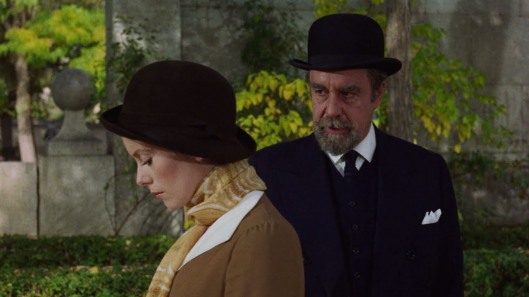 While director Luis Buñuel is well known for his association with Surrealism, not all of his films employ the same blatantly subversive approach as his collaboration with Salvador Dali, Un Chien Andalou (Andalusian Dog). In fact, often the “surreal” qualities of his films derive less from explicit violent or sexual transgression than from sophisticated understatement about a waking world we accept without question.
While director Luis Buñuel is well known for his association with Surrealism, not all of his films employ the same blatantly subversive approach as his collaboration with Salvador Dali, Un Chien Andalou (Andalusian Dog). In fact, often the “surreal” qualities of his films derive less from explicit violent or sexual transgression than from sophisticated understatement about a waking world we accept without question.
Tristana, a relatively late (1970) effort starring Catherine Deneuve in the title role, is a case in point. Befriended by Don Lope (Fernando Rey) after the death of her mother, Tristana is a devout innocent who over time recognizes the hypocrisies of her womanizing benefactor. Both the “daughter” and de facto “wife” of Don Lope without the protections of either role, Tristana grows to hate him and escapes his clutches only by running away with a virile young artist, Horacio (Franco Nero).
Superficially at least, the setup is more or less standard domestic melodrama and indeed, there is little in the action that violates generic expectations. And yet the film never exploits easy outrage to make us feel entirely sympathetic. As just one example, while the situation would seem to make Tristana an unambiguous victim, particularly when played by a luminous star like Deneuve, she never fully connects emotionally. That is partly because for all his possessiveness, Don Lope lets Tristana do more or less whatever she pleases (including her relationship with Horacio) as long as she does not leave him. Her feelings about Don Lope are more mixed than she cares to admit, perhaps in a tacit recognition of the advantages she enjoys.
This dual awareness percolates under Buñuel’s unforced, almost placid style. With the exception of a single recurring nightmare, the movie avoids Surrealism’s dream world ruptures to course in a seductively sensual flow, embroidering Tristana’s story with a wealth of extraneous detail that reveals the irrationality of the everyday. Don Lope’s refusal to serve as a judge in a duel, or the sudden, gratuitous appearance of a rabid dog, or the masturbatory habits of Don Lope’s servant’s son, or the fights between manual laborers and the police are just a few of the random events that happen with the casual unpredictability of life itself. The potentially intense drama of the central conflict is leveled by a matter-of-fact, relaxed familiarity, which is particularly notable given that the film’s large-scale period recreation probably involved considerable expense and care.
Given the director’s history and reputation, it is would be foolish to interpret this calm for sympathy or indifference, however. It is just that he recognizes Don Lope as a multi-faceted villain. With Rey’s help, Buñuel makes him a charming, self-satisfied reprobate totally unaware of, much less perturbed by his contradictory role as father/protector and lover. By treating Don Lope with such silky irony, the film demonstrates how ordered finesse often hides deep pathologies. To the discerning, Tristana’s one explicit nightmare pales in the bright sunshine of a dubious normality.